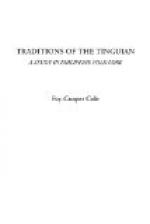The purely ritualistic tales, called diams, are learned word by word by the mediums, [1] as a part of their training for their positions, and are only recited while an animal is being stroked with oil preparatory to its being sacrificed, or when some other gift is about to be presented to the superior beings. The writer has recorded these diams from various mediums in widely separated towns and has found them quite uniform in text and content. The explanatory tales were likewise secured from the mediums, or from old men and women who “know the customs.” The stories of the last division are the most frequently heard and, as already indicated, are told by all. It is evident even to the casual reader that these show much more evidence of outside influence than do the others; some, indeed, appear to have been recently borrowed from the neighboring christianized Ilocano. [2]
Tales of the Mythical Period
Reconstruction of the Culture.—In the first division certain actors occur with great frequency, while others always take the leading parts. These latter appear under a variety of names, two or more titles often being used for the same individual in a single tale. To avoid confusion a list of the fourteen principal actors and their relationships are given in the accompanying table. It will appear that there are some conflicts in the use of names, but when it is realized that the first twenty-six myths which make up the cycle proper were secured from six story tellers coming from four different towns, the agreement rather than the disagreement is surprising. As a matter of fact there is quite as much variation between the accounts of the same narrator as between those gathered from different towns.
Table of Leading Characters [3]
I. Aponitolau. Son of Pagatipanan [male] [4] and Langa-an [female] of Kadalayapan; is the husband of Aponibolinayen. Appears under the following names: (a) Ligi, (b) Albaga of Dalaga, (c) Dagdagalisit, (d) Ingiwan or Kagkagakag, (e) Ini-init, (f) Ling-giwan, (g) Kadayadawan, (h) Wadagan, (i) Awig (?)
II. Aponigawani. Sister of Aponitolau and wife of Aponibalagen.
III. Aponibolinayen. Daughter of Pagbokasan [5] [male] and Ebang [female] of Kaodanan. Wife of Aponitolau.
Appears as (a) Ayo, (b) Dolimaman(?).
IV. Aponibalagen. Brother of Aponibolinayen,
and husband of
Aponigawani; also appears as Awig.
V. Kanag. Son of Aponitolau and Aponibolinayen. Appears as (a) Kanag kabagbagowan, (b) Balokanag, (c) Dumanau, (d) Ilwisan, (e) also at times is identified with Dumalawi, his brother.
VI. Dapilisan, wife of Kanag.
VII. Dagolayan. Son of Aponibalagen and
Aponigawani. Also appears as
Dondonyan of Bagonan—the blood clot child.
VIII. Alokotan. An old woman who acts as a medium. Her home is at Nagbotobotan, where the rivers empty their waters into the hole at the edge of the world.




